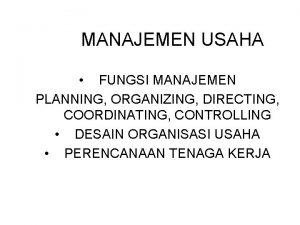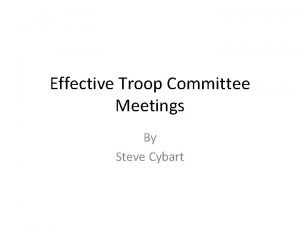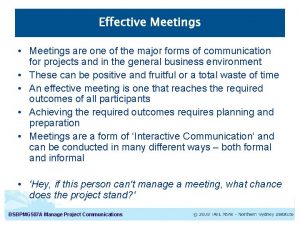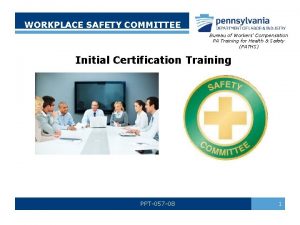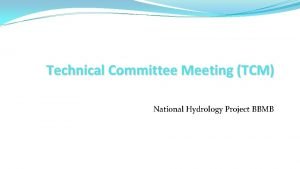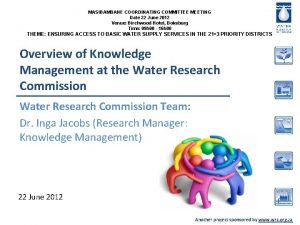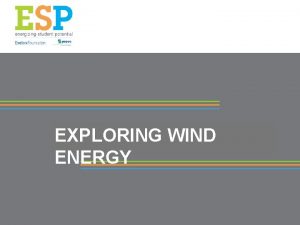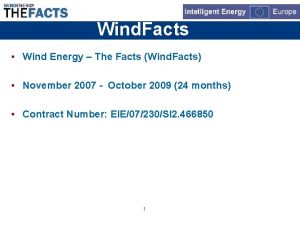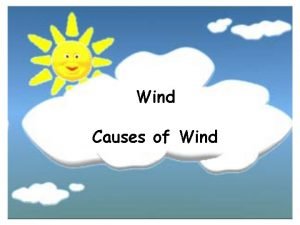National Wind Coordinating Committee Planning Meeting June 3








- Slides: 8

National Wind Coordinating Committee Planning Meeting June 3 -4, 2003 Portland, Oregon Dean Perry Chair - SSG-WI Planning WG 1

Overview • Overview of SSG-WI Planning work • How it is related to NWCC Draft Transmission Planning Principles Paper 2

What is SSG-WI? • A seams coordination forum sponsored by the 3 proposed RTOs in the West (Principle 8. ) • Steering Group and WGs are open, everyone is ENCOURAGED to participate • SSG-WI PWG – Those now involved include state agency representatives, resource developers (wind and coal), marketers, IOUs, public utilities (Principle 2. ) • RTOs make final decisions and implement 3

Organization Chart RTO West. Connect Principals in Consultation with RRG CAISO Interim Committee (Regional Representatives Group) Board Seams Steering Group Transmission Planning Chair: Dean Perry Market Monitoring Chair: Kristi Wallis Chair – Bud Krogh RTO West. Connect Charlie Reinhold Frank Afranji Cary Deise Rich Bayless Greg Miller Yakout Mansour Ed Beck (Alt) Syd Berwager (Alt) CAISO Elena Schmid Steve Greenleaf Armie Perez Price Reciprocity Chairs: Phil Pettingill Chris Elliott Congestion Management Alignment Chair: Wally Gibson Common Systems Interface Coordination (CSIC) Chair: Don Watkins 4

SSG-WI Planning Function • SSG-WI does transmission Planning (identifies needs, runs studies, identifies solutions)- - conceptual ideas, pre- to early- WECC process (Principle 3. ) • Doing “congestion relief” planning (to expand current capability), not “reliability” planning (to maintain current capability). Utilize reliability planning of individual entities as input. (Principle 7) • Focus is on forecasting future uneconomic congestion and developing alternative solutions (transmission and non-transmission) • Looking West-wide, not Subregional (Principle 1. ) • Analyze historical congestion – Report on SSG-WI Web Site 5

SSG-WI Planning Function • SSG-WI supports WECC project review procedures and WECC reliability criteria and standards • SSG-WI does not sponsor projects or implement projects • SSG-WI will support state siting and permitting processes as requested • Plan to issue Annual Transmission Reports – First report scheduled for release in September 2003 6

2003 Planning Study • 2008 – – based upon resources to be on line by Jan 2004 plus others on-line during 2004 – hydro and gas price sensitivities – Transmission energized by 2008 – Identify potential areas of transmission congestion • 2013 – – looking at 3 resource scenarios: coal, renewable, and gas (Principle 4) – hydro and gas price sensitivities – Identify areas of congestion & evaluate alternative solutions 7

SSG-WI Process Chart (DRAFT) 8
 Trade promotion coordinating committee
Trade promotion coordinating committee Staffing planning organizing directing controlling
Staffing planning organizing directing controlling Raumschotkurs
Raumschotkurs Boy scout troop committee organization chart
Boy scout troop committee organization chart Steering committee meeting agenda sample
Steering committee meeting agenda sample Pa safety committee certification
Pa safety committee certification Tcm technical committee meeting
Tcm technical committee meeting For today's meeting
For today's meeting Today meeting or today's meeting
Today meeting or today's meeting

